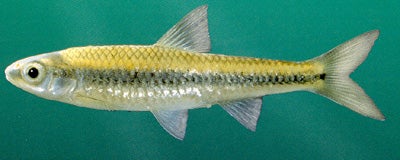COASTAL SHINER
SCIENTIFIC NAME: Notropis petersoni
CHARACTERISTICS: Notropis petersoni is a small minnow with a fairly compressed body, a blunt, overhanging snout. and a terminal mouth. The black lateral band is well developed, extending from the snout to the tail. The caudal spot is small, wedge-shaped, and narrower than the lateral band. Scales below the lateral band lack pigment, and all rays of the anal fin are lightly outlined with melanophores. In live individuals, the back is olive yellow, with an overall body color of light brown to olive yellow. Swift (1970) indicated that specimens from highly stained waters may be salmon in color with pinkish fins. The coastal shiner may be confused with the similarily colored weed shiner, N. texanus, but the two can be seperated according to tail pigmentation. Melanophores outline all anal fins on the coastal shiner, but only the last four rays on the weed shiner.
Adult Size: 1.6 to 2.6 in. (40 to 65 mm)
Distribution: The coastal shiner occurs in Atlantic and Gulf slope drainages from the Cape Fear River south to Lake Okeechobee and west to the Jordan River system in Mississippi. In Alabama the range is limited to scattered collections from eastern and western tributaries to Mobile Bay, the Mississippi Delta, the lower Alabama River, and the Perdido, Conecuh, and the Chattahoochee systems.
Habitat and Biology: Typically an inhabitant of slow backwaters, lakes, and impoundments near coastal areas, N. petersoni is also found in coastal tidewater areas and in small blackwater inland streams draining to coastal bays. Spawning occurs from April to June in Alabama. Davis and Louder (1971) report spawning from May to late August and a life span of more than three years in North Carolina. The coastal shiner is a midwater feeder, consuming drifting immature and adult insects, plant detritus, algae, and crustaceans.
Original Description: Fowler described the coastal shiner in 1942
Etymology:
Notropis means keeled back.
Petersoni is in honor of C. Bernard Peterson, who assisted in collecting the type specimens.
The copyrighted information above is from Fishes of Alabama and the Mobile Basin.






